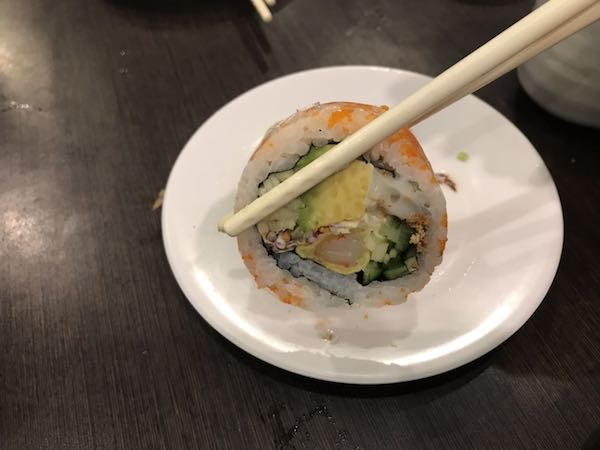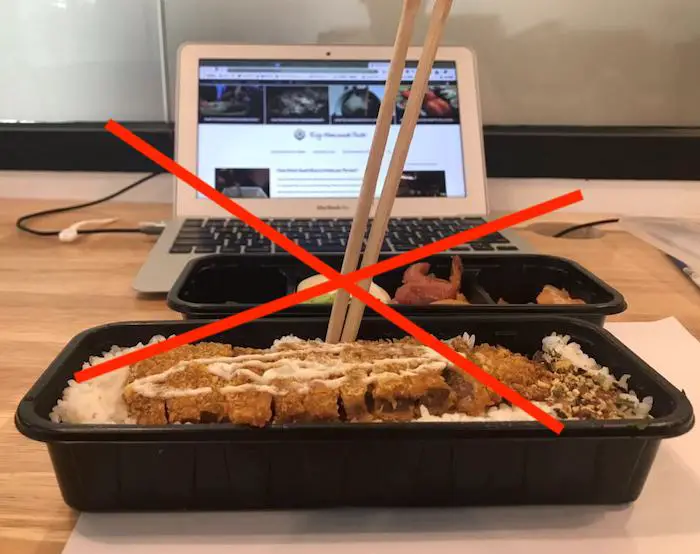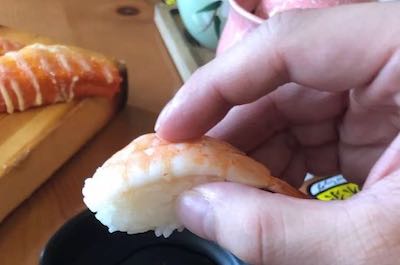We are reader supported. When you purchase through links on our site, we may earn an affiliate commission. Also, as an Amazon affiliate, we earn from qualifying purchases.

If you are brand new to eating sushi, you may be experiencing a little anxiety about proper sushi etiquette. I get a lot of questions about what to order first, which makes sense. But another common question is how to eat sushi in the first place. If you are wondering if it’s okay to eat sushi with your hands, you’re not alone. Below, I’ll discuss proper sushi etiquette.
Do you eat sushi with hands or chopsticks? The answer is that it really depends. Different cultures and locales will have their own social rules that go along with sushi dining, so your best bet is to watch what the other patrons do. Generally speaking, you can use your hands to eat
That answer should get you started with your first sushi dining experience, but if you want to really be prepared, you should keep reading. There are a number of important traditions and tips below that can help you blend in and feel more confident during your first few sushi meals.
Contents
How to eat sushi
One of the most common questions I get is how to eat sushi. To anyone used to this unique and flavorful cuisine, the question may seem silly. To newbies, however, it’s often a point of anxiety. You don’t want to offend the sushi chef or upset the other diners, so it’s natural to be nervous and have lots of questions. Let me help set your mind at ease.
A few pointers before we begin:
- Politeness is key
- Ask questions if you’re unsure
- Don’t be afraid to ask for recommendations
- Order only what you can eat
- Have good table manners
- Thank the chef, wait staff, and host or hostess
- Sushi and sashimi are not the same thing
Related Article: What Do Sushi Chefs Say When You Enter?
What to expect at a fine sushi restaurant
There are many types of sushi establishments, and how you’re treated will vary greatly between them. Quick sushi joints are less likely to have all the bells and whistles or expect you to perform any particular rituals, while upscale sushi restaurants will expect you to know the ropes. Below, I’ll cover what you can expect from the top tier sushi places, but your actual experience may vary.
Seating
You will be greeted by the hostess or host. It’s polite to say hello and give a smile. Don’t feel obligated to engage the host or hostess in conversation if you’re not comfortable doing so, but do be polite. The staff is more likely to treat you kindly if you treat them with respect.
You will likely be led to your seat shortly after you arrive. If you prefer a table or would like to sit at the bar, say so. If you don’t care to watch the itamae (the sushi chef) prepare your food, or you don’t wish to have a conversation with them, it’s best to leave the bar seats to those who wish to have that interaction.
Ordering
If you’re seated at a table, your waiter or waitress will be able to help you select appropriate foods. If you’re at the bar, only ask the itamae about sushi. Anything else, such as drinks, soup, and non-sushi items (such as sashimi) should be brought up with the wait staff.
Go ahead and ask the itamae what they recommend. Never ask about the freshness of the ingredients—it’s considered rude. If you’re unsure of the freshness, that isn’t a place you should be eating anyway. When you ask the itamae for recommendations, they will likely point you toward their specialties.
Give it a try if it sounds good. However, don’t feel forced into eating something you know you won’t like.
It’s considered rude to leave food on your plate or to make faces or comments about things you don’t like. This is why it’s important to consider your likes and dislikes before ordering. Also, only order as much as you can eat in one sitting.
Sushi or sashimi?
Sushi is vinegared rice with toppings or fillings. This is what most people think of when they say sushi. It may contain meat or fish, but not always. The meat or fish may be raw or cooked.
Sashimi is always raw fish, sliced thin, served without rice.
Related Article:Difference Between Nigiri, Sashimi, Sushi Roll, Hand Roll, Gunkan Sushi
How to eat sushi and sashimi: Chopsticks or hands?
And now the real conundrum! How the heck do you eat such beautiful, delicate-looking food? You may be used to simply diving into your meals, but sushi requires a bit more tact.
A general rule is that anything with rice that’s rolled up, piled up, or combined in an eye-catching manner is sushi and is usually okay to eat with your hands. They’re designed to be consumed in one or two bites anyway. Traditional sushi is always small enough for one bite, but American sushi is sometimes way too big for that to happen. It’s okay if you can’t fit a large portion in one bite.

You can eat sushi with chopsticks if you prefer. It can take some practice to get the grip right, but it’s worth it. Chopsticks help you control how much of the food is dipped and at what angle you consume it.
Sashimi is always eaten with chopsticks. It can be slippery and unwieldy in your fingers. And frankly, it just looks gross and weird to pick up slices of raw meat with your fingers.
P.S. Sashimi is not sushi. Just bring it up because most people think it is. You can have a
When dipping your sushi, be sure to dip the fish, meat, or vegetable portion. If you try to dip the rice, the whole thing could fall apart because rice absorbs so much. It’s like a sponge! That’s where the chopsticks really come in handy.
Other sushi etiquette and notes
The biggest issue for newbie sushi enthusiasts and curious diners is whether or not to use chopsticks. While I agree that this is an important question, it’s also worth noting some of the other expectations.
Don’t be surprised if you are offered a hot towel before your meal. This is a customary way to prepare yourself. Simple wipe your hands, then fold the towel as neatly as possible and set it aside. Don’t just crumple it up—that’s considered rude.
Your chopsticks are not toys. Don’t rub them together, bang them on the table, or play “drums” with them. That’s considered extremely rude. If you’re not using them, place them on the holder or the shoyu dish.

Do not stick your chopsticks into your rice. It will look too much the incense used during funeral rites and prayers to ancestors. Definitely not good table manners!
It’s considered polite to offer to buy the itamae a drink. Don’t try to get them drunk, but do offer a drink. It shows respect.
Conclusion
The bottom line for sushi is that using chopsticks is part of the experience. It’s okay if you’re not very good at it to begin with. They don’t expect perfection! But don’t be afraid to try using chopsticks.
That said, there are many sushi places that encourage you to use your hands! Some sushi chefs love to see their patrons experiencing the textures and temperatures of their foods, so don’t be surprised if everyone is digging in with their hands.
If in doubt, you can always ask the wait staff or the itamae. For more sushi eating etiquette, you can have a look at my previous article: How To Eat Sushi In Japan (Sushi Eating Etiquette)
Related Questions
Do Japanese people eat sushi with their hands?
Yes, but this can vary. Sushi is designed to be eaten in one bite and to be held with the hands. However, it comes down to personal preference and the acceptable etiquette at specific restaurants.
How to eat sushi with wasabi?
Generally, the
To add more wasabi to your sushi, take a small amount of wasabi onto your chopsticks, then place it on top of the fish, meat, or vegetable toppings. Do not mix your wasabi into the soy sauce dish—this is considered rude in many places and it makes a big mess.
Related Article: How to Make Real Wasabi at Home?
Do you eat sushi whole?
Yes, in most cases. Sushi is designed to be eaten in a single bite. Traditional sushi is small enough for one bite, but American sushi is often too big for a single bite. If it is physically impossible to eat a large piece in one bite, it’s okay to eat it in two.
Is it okay to eat sushi with a fork?
Not usually. The reason is that sushi is made to be picked up and eaten in a single bite. That can be with your hands or with chopsticks. Using a fork requires stabbing the sushi, which will change the shape. A fork may even disrupt the sushi so much that it falls apart, making it impossible to eat in a single bite. You also risk insulting the



Comments
Pingback: Is Sushi Good For A First Date? - Easy Homemade Sushi